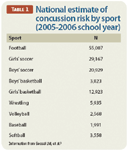Concussion in the young athlete: Diagnosis, management and prevention
Sports are one of the leading causes of injury to adolescents. Sports injuries are the second leading cause of traumatic brain injury among 15- to 24-year olds.

Key Points
Sports are one of the leading causes of injury to adolescents. Sports injuries are the second leading cause of traumatic brain injury among 15- to 24-year-olds, with motor vehicle accidents being the leading cause.1,2 Concussions represent 8.9% of all high school sports injuries and 5.8% of all collegiate sports injuries.3
In sports in which both males and females participate, females have been shown to have higher rates of concussion.3 It has been estimated that 300,000 sport-related traumatic brain injuries occur each year across all age groups, but more recent data, including recreational and club sports, suggest that up to 3.8 million occur annually.4
Injuries with loss of consciousness are estimated to occur at a rate of 9.3 injuries per 100 adolescents per year.5 Because athletes often are eager to return to play, they often fail to report injuries and symptoms or receive medical care until well after the injury. Therefore, the estimates of concussion rates likely are low given that coaches may fail to recognize the signs and symptoms and/or athletes may underreport their symptoms.
Definition of concussion
The Third International Conference on Concussion in Sport (CIS) defined concussion as a "complex pathophysiological process affecting the brain, induced by traumatic biomechanical force."6 Concussions may be caused by a direct blow to the head, face, neck, or elsewhere on the body, with an impulsive force transmitted to the head. Typically, concussion results in the rapid onset of short-lived impairment of neurologic function that resolves spontaneously. There may be neuropathologic changes, but the acute clinical symptoms largely reflect a functional rather than a structural injury. There also may be a graded set of clinical symptoms that may or may not involve loss of consciousness. Resolution of the clinical and cognitive symptoms typically follows a sequential course; however, it is important to note that in a small percentage of cases postconcussive symptoms may be prolonged. Concussion results in no abnormality on standard structural neuroimaging studies.
Risk factors for concussion
HIGH-RISK SPORTS

In general, competition is associated with greater rates of concussion than practice. However, girls' softball, volleyball, and cheerleading were shown to have higher rates of practice-related injuries compared with injuries occurring in competition.3,7
OTHER RISK FACTORS
History of concussion is a moderately strong risk factor for future concussion. One cohort study demonstrated a 2-fold increase in concussion rate in the setting of prior concussion.7,8 Lower body mass index also appears to be associated with increased rates of concussion.7